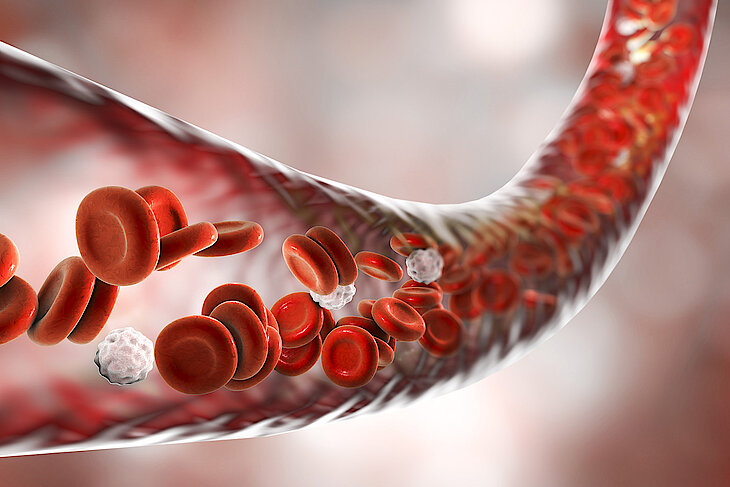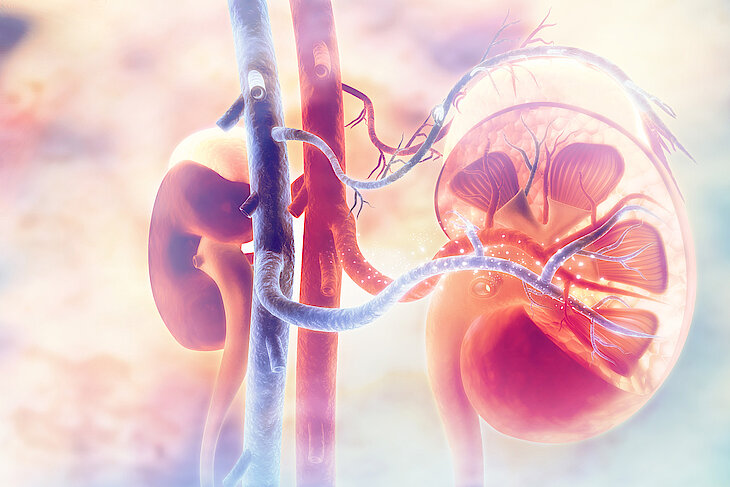Sepsis is a medical emergency
The global burden of sepsis worldwide counts for 49 million cases a year, with a high mortality rate of 11 million sepsis-related deaths (1). In Germany alone, over 320,000 patients per year are affected by sepsis (2) showing that sepsis is not only a disease in poor or middle-income countries. Recent research has identified new molecules that help clinicians understand the etiology of the patient’s clinical symptoms, paving the way for a tailored medicine approach in the field of sepsis.

Endothelial dysfunction - a major cause of shock in sepsis (3)
Research findings
The endothelium is the interior wall of the blood vessels that acts as a barrier separating the blood from its surroundings. The hormone controlling this barrier function is bioactive Adrenomedullin 1-52 (bio-ADM*). In sepsis patients, the blood vessels become leaky and more bio-ADM is produced to re-seal the compromised barrier. But this hormone also expands the blood vessel, leading to a drop in blood pressure (4).
This blood pressure drop leads to organ hypoperfusion, which routinely is monitored using lactate, a parameter that identifies reduced blood oxygenation of tissue and is used for the diagnosis of septic shock. However, lactate is rather unspecific to sepsis since it is influenced by many other physiological and pathological processes (5). By measuring the levels of bio-ADM in the blood, it is possible to early identify patients at risk of shock and guide vasoprotective therapy (6). Since bio-ADM is an active hormone, an increase or decrease in the blood levels also allows to monitor the therapy success (7).

Acute kidney injury is a frequent complication in sepsis
Research findings
One in two critically ill patients develop acute kidney injury (AKI) and are at increased risk of both severe morbidity and higher mortality (8). In addition, about 30% of AKI cases in ICU are due to nephrotoxic drug administration (9). Sepsis in particular is a condition in which mortality is linked to organ dysfunction, and AKI occurs in 40-50% of septic patients (10). Serum creatinine is the current diagnostic standard and is used to calculate the creatinine-based estimation of glomerular filtration rate (eGFR), a surrogate parameter quantifying kidney function.
This assessment ideally uses more than one measurement and creatinine metabolism is affected by patient-related factors, including age, gender, ethnicity, body and muscle mass, metabolism, nutritional status, and diet (11), as well as by inflammation, fluid overload, and the use of nephrotoxic agents (12, 13). Accumulating evidence shows that by indirectly measuring the levels of the kidney-stimulating hormone enkephalin, impaired kidney function can be detected (14). Proenkephalin A 119-159 (penKid*) is a small fragment of the enkephalin prohormone that is released during enkephalin production and has been shown to strongly correlate with the true glomerular filtration rate (true GFR) in normal subjects and critical care patients (14, 15). Moreover, measuring the penKid levels can predict AKI, and worsening and improving of kidney function independently from inflammation (13, 16, 17, 18) and common comorbidities, e.g. hypertension and diabetes (16).
*Disclaimer
Sphingotest® penKid®, sphingotest® bio-ADM® are offered for research use only. “penKid” and “bio-ADM” represent the analytes Proenkephalin A 119-159, and bioactive Adrenomedullin 1-52 respectively.
Reference Literature
(1) Rudd et al. (2020), Global, regional, and national sepsis incidence and mortality, 1990–2017: analysis for the Global Burden of Disease Study, The Lancet.
View the paper
(2) Fleischmann-Struzek et al. (2018), Challenges in assessing the burden of sepsis and understanding the inequalities of sepsis outcomes between National Health Systems: secular trends in sepsis and infection incidence and mortality in Germany, Intensive Care Med.
View the paper
(3) Ince et al. (2016), THE ENDOTHELIUM IN SEPSIS. Shock.
View the paper
(4) Geven et al. (2018), Adrenomedullin and Adrenomedullin-Targeted Therapy As Treatment Strategies Relevant for Sepsis. Frontiers in immunology.
View the paper
(5) Singer et al. (2016), The Third International Consensus definitions for sepsis and septic shock (sepsis-3). JAMA.
View the paper
(6) Di Somma et al. (2022), Can Acute Care Biomarkers Change Patient’s Management in Sepsis? Eurasian J Emerg Med.
View the paper
(7) Caironi et al. (2017), Circulating Biologically Active Adrenomedullin (bio-ADM) Predicts Hemodynamic Support Requirement and Mortality During Sepsis. Chest.
View the paper
(8) Hoste et al. (2015), Epidemiology of acute kidney injury in critically ill patients: the multinational AKI-EPI study. Intensive Care Med.
View the paper
(9) Pazhayattil et al (2014), Drug-induced impairment of renal function. Int J Nephrol Renovasc Dis.
View the paper
(10) Gomez et al (2016), Sepsis-induced acute kidney injury, Curr Opin Crit Care.
View the paper
(11) Schaeffner 2017: Determining the glomerular filtration rate – an overview. Journal of Renal Nutrition.
View the paper
(12) Caironi P, et al. (2018): Circulating Proenkephalin, acute kidney injury, and its improvement in patients with severe Sepsis or shock. Clin Chem.
View the paper
(13) Moledina DG, et al. (2018): Phenotyping of acute kidney injury: beyond serum Creatinine. Semin Nephrol.
View the paper
(14) Beunders et al. (2020), Proenkephalin compared to conventional methods to assess kidney function in critically ill sepsis patients, Shock.
View the paper
(15) Donato et al. (2018), Analytical performance of an immunoassay to measure proenkephalin. Clin Biochem.
View the paper
(16) Hollinger et al. (2018), Proenkephalin A 119-159 (Penkid) is an early biomarker of septic acute kidney injury - the kidney in sepsis and septic shock (Kid-SSS) study, Kidney Int Rep.
View the paper
(17) Kim et al. (2017), Proenkephalin, Neutrophil Gelatinase-Associated Lipocalin, and Estimated Glomerular Filtration Rates in Patients With Sepsis. Ann Lab Med.
View the paper
(18) Marino et al. (2015), Diagnostic and short-term prognostic utility of plasma proenkephalin (pro-ENK) for acute kidney injury in patients admitted with sepsis in the emergency department, J Nephrol.
View the paper

